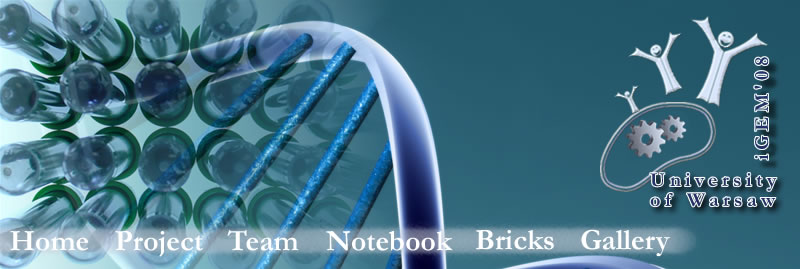Wiki/Team:Warsaw/protocols
From 2008.igem.org
MKrzyszton (Talk | contribs) |
|||
| Line 3: | Line 3: | ||
<html> | <html> | ||
| | ||
| + | <table class=month width=100%> | ||
| + | <tr> | ||
| + | <td width=50%><a href=javascript:history.back()><img src="https://static.igem.org/mediawiki/2008/4/45/Previous_page.png" alt="Back to previous page"></a></td> | ||
| + | <td><a href=https://2008.igem.org/wiki/Team:Warsaw/igem_notebook.htm><img src="https://static.igem.org/mediawiki/2008/d/da/Up.png" alt="Notebook view"></a></td> | ||
| + | </tr></table> | ||
<a name="Z_a_Z_o"><h3>Purification of His_Z_alpha and His_Z_omega</h3></a> | <a name="Z_a_Z_o"><h3>Purification of His_Z_alpha and His_Z_omega</h3></a> | ||
Revision as of 21:56, 29 October 2008
 |
||||||||||||||||||||||||||||||||
|
Purification of His_Z_alpha and His_Z_omegaCulture E. coli producer strain in 10 ml of liquid LB medium for 8 hours. Then use it to inoculate 1000 ml of liquid LB medium with 0,5 mM IPTG and grow it overnight. In the morning spin down the culture (5000 RPM, 10 min, 4°C). Resuspend the pellet in PBS buffer and disrupt cells by sonication. Spin down sonication mixture (13200 RPM, 10 min, 4°C) and discard supernatant – protein is present in sonication debris. Resuspend it in sterile ice cold ddH2O and Spin down (13200 RPM, 10 min, 4°C). Discard supernatant and resuspend it in sterile ice cold ddH2O and store at 4°C. Purification of His_A_alphaCulture, induce and disrupt E. coli in the same way as to purify His_Z_alpha. The protein is present in supernatant (about 10% of total protein) and can be added to selection medium without further purification. Nevertheless we purified it to determine how much exactly should be added:
Testing various hunter/prey combinations
Plasmid DNA isolationWe use "Plasmid Mini" plasmid DNA isolation kit from A&A Biotechnology and follow the protocol of producer. DNA isolation from agarose gelWe use "Gel-Out" DNA isolation kit from A&A Biotechnology and follow the protocol of producer. DNA purification after enzymatic reactionWe use "Clean-Up" DNA purification kit from A&A Biotechnology and follow the protocol of producer. Genomic DNA isolationWe use "Genomic-Mini" universal genomic DNA isolation kit from A&A Biotechnology and follow the protocol of producer. DNA digestWe use restriction enzymes and buffers provided by Fermentas. Overall volume of digest mix is either 20 μl, either 50 μl in case of digesting for ligation. We usually use 1 μl of restriction enzyme and the buffer in 10x dilution (as they initially are 10x concentrated). The rest of mix is plasmid DNA.
Control digests are set up for 1 hour. Preparation of chemocompetent bacteriaKeep the bacteria on ice during the procedure. Pour ca. 25 ml of bacteria into a falcon tube and spin at 4°C at 4 krpm, 8 min with prolonged acceleration and deceleration. Remove supernatant. The pellet mustn't run dry. You can pour another portion of bacteria onto it and spin again. After desired amount of bacteria in pellet is collected, add CaCl2 in an amount of 10% of initial culture used for spinning. Suspend the pellet until no debris is visible on the bottom. Incubate 45 min on ice. Then spin 8 min at 4 kg and remove supernatant. Suspend the pellet in 3 ml CaCl2 and divide into aliquots of 100 μl. Preparation of electrocompetent bacteria
Electrotransformation
ChemotransformationAdd desired volume of DNA to the 100-μl-culture in eppendorf tube. Incubate 30 min on ice. Heat shock for 90 s at 42°C. Incubate 10 min on ice. Add 0.9 ml of culture medium and let the bacteria grow at 37°C. LigationWe use the following mixture:
Overall mix volume is 20 μl. DNA ends blunting
Prepare digestion mix in overall volume of 50 μl.
Standard concentrations of antibiotics and other supplements
Ampicillin Rifampicin test
Removing 5' phosphate groups from DNA ends
TAXI protocol (Tet+Ap 30+X-Gal+IPTG)
Protein concentration measurement (BCA method)
PCRMost PCR was carried out in following conditions: PCR standard mix To obtain PCR product for cloning (50 μl) Polymerase Chain LigationIt's PCR reaction on two partially complementing templates. In our project all fusions containing linkers were put together using this technique. Typical mix: Note about cycling conditions: It's very important to check that melting temperature of complementing region is lower than elongation temperature, thus in all of our PCL reactions elongation was carried out at 68°C | ||||||||||||||||||||||||||||||||
 "
"

